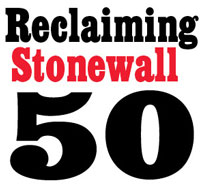 Trans women of color helped start the fight for LGBTQ liberation, but 50 years after Stonewall, they have been left out and left behind. Erasing them from the struggle for freedom has had devastating consequences. They have been denied the limited gains secured by the movement that they helped launch.
Trans women of color helped start the fight for LGBTQ liberation, but 50 years after Stonewall, they have been left out and left behind. Erasing them from the struggle for freedom has had devastating consequences. They have been denied the limited gains secured by the movement that they helped launch.
This is not surprising. The patriarchy, misogyny, and racism at the heart of trans exclusion has held back progress since America’s inception. Centering trans women of color is essential to building a movement that benefits everyone. The way activism has been done since 1969 isn’t working.
The numbers tell the story: The United States has more murders of trans people than any other country, save for two: Brazil and Mexico. So far this year, all of the trans women killed in the United States have been women of color, and only one made it past the age of 30. This year isn’t an anomaly either; 2016 and 2017 were the most violent years for LGBTQ people on record.
But the violence isn’t just physical. Black transgender and gender non-conforming people experience extreme poverty, with rates that are 70 percent higher than the LGBTQ population overall and eight times higher than the general population.
Though much remains disputed about who threw the first punch or Molotov cocktail the night of June 28, 1969, at the Stonewall Inn, we know that trans and gender non-conforming people of color were in the vanguard. Due to the painstaking work of LGBTQ scholars, activists, and media makers, the names of Marsha P. Johnson, Sylvia Rivera, Miss Major, and Stormé DeLaverie have now entered into the official history. Marsha and Sylvia will have statues dedicated to them at the Stonewall site. But trans and gender non-conforming people of color had to be written into the accounts, because they were deliberately written out.
It took just four years for trans women of color to be pushed to the margins of the movement. At the 1973 march and rally at Washington Square Park, organizers banned Rivera from speaking. Despite the prohibition, she fought her way to the stage. To the boos and jeers of the thousands, she shouted through her tears, “I have been beaten, lost my job, lost my apartment for gay liberation, and ya’ll treat me this way?” Rivera went on to call the post-1973 gay liberation movement a “white middle class, white club.”
As the years went on, gay white men took over more and more of the movement. They created organizations that have become establishment institutions. Their efforts to mainstream gay rights is why same-sex couples can marry today. But marriage became such a juggernaut in the community that it consumed eight out of every 10 dollars that have been raised for all LGBTQ issues since 1970, according to Seattle University Assistant Professor Joseph DeFilippis.
Marriage equality was never going to be a panacea. It did nothing, for instance, about the 30 states where it is legal to discriminate against LGBTQ people. In fact, the issues of the gay and lesbian community echo those of trans communities of color much more than those of the Buttigiegs or wealthy donors to the leading establishment groups. Gays and lesbians are more likely to face employment discrimination, poverty, and violence than the public-at-large.
The only way forward is to return the movement to its roots. By placing trans women of color at the center of the LGBTQ movement, we will center their issues. And by building this intersectional fight, we will actually advance the interests of the majority. After five decades, it is past time.


